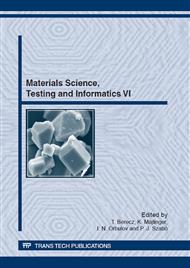[1]
J. Pang and I. Bond, A hollow fibre reinforced polymer composite encompassing self-healing and enhanced damage visibility, Composites Science and Technology. 65 (2005) 1791-1799.
DOI: 10.1016/j.compscitech.2005.03.008
Google Scholar
[2]
R. Trask, G. Williams and I. Bond, Bioinspired self-healing of advanced compositte structures using glass hollow fibres, Journal of the Royal Society. 4 (2007) 363-371.
DOI: 10.1098/rsif.2006.0194
Google Scholar
[3]
Y. C. Yuan, T. Yin, M. Z. Rong and M. Q. Zhang, Self healing in polymers and polymer composites. Concepts, realization and outlook: A review, Express Polymer Letters. 2 (2008) 238-250.
DOI: 10.3144/expresspolymlett.2008.29
Google Scholar
[4]
M. R. Kessler, N. R. Sottos and S. R. White, Self-healing structural composite materials, Composites Part A: Applied Science and Manufacturing. 34 (2003) 743-753.
DOI: 10.1016/s1359-835x(03)00138-6
Google Scholar
[5]
R. Trask, H. Williams and I. Bond, Self-healing polymer composites: mimicking nature to enhance performance, Bioinspiration & Biomimetics. 2 (2007) p.12.
DOI: 10.1088/1748-3182/2/1/p01
Google Scholar
[6]
S. White, N. Sottos, P. Geubelle, J. Moore, M. Kessler, S. Sriram, E. Brown and S. Viswanathan, Autonomic healing of polymer composites, Nature. 409 (2001) 794-797.
DOI: 10.1038/35057232
Google Scholar
[7]
H. Williams, R. Trask, A. Knights, E. Williams and I. Bond, Biomimetic reliability strategies for self-healing vascular networks in engeneering materials, Journal of the Royal Society Interface. 5 (2008) 735-747.
DOI: 10.1098/rsif.2007.1251
Google Scholar
[8]
A. R. Hamilton, N. R. Sottos and S. R. White, Self-healing of internal damage in synthetic vascular materials, Advanced Materials. 22 (2010) 5159-5163.
DOI: 10.1002/adma.201002561
Google Scholar
[9]
K. S. Toohey, N. R. Sottos, J. A. Lewis, J. S. Moore and S. R. White, Self-healing materials with microvascular networks, Nature Materials. 6 (2007) 581-585.
DOI: 10.1038/nmat1934
Google Scholar
[10]
C. Dry, Matrix cracking repair and filling using active and passive modes for smart timed release of chemicals from fibers into cement matrices, Smart Materials and Structures. 3 (1994) 118-123.
DOI: 10.1088/0964-1726/3/2/006
Google Scholar
[11]
M. Motuku, U. Vaidya and G. Janowski, Parametric studies on self-repairing approaches for resin infused composites subjected to low velocity impact, Smart Materials and Structures. 8 (1999) 623-638.
DOI: 10.1088/0964-1726/8/5/313
Google Scholar
[12]
R. Trask, G. Williams and I. Bond, Bioinspired and biomimetic self-healing of advanced composite materials in: 13th European Conference on Composite Materials, Stocholm, Sweden, (2008), p.2.
Google Scholar
[13]
G. Williams, I. Bond and R. Trask, Compression after impact assessment of self-healing CFRP, Composites Part A: Applied Science and Manufacturing. 40 (2009) 1399-1406.
DOI: 10.1016/j.compositesa.2008.05.021
Google Scholar
[14]
G. Williams, R. Trask and I. Bond, A self-healing carbon fibre reinforced polymer for aerospace applications, Composites Part A: Applied Science and Manufacturing. 38 (2007) 1525-1532.
DOI: 10.1016/j.compositesa.2007.01.013
Google Scholar
[15]
H. Williams, R. Trask and I. Bond, Self-healing sandwich panels: Restoration of compressive strength after impact, Composites Science and Technology. 68 (2008) 3171-3177.
DOI: 10.1016/j.compscitech.2008.07.016
Google Scholar
[16]
EN ISO 5079, Textiles - Fibres, Determination of braking force and elongation at break of individual fibres (1995).
DOI: 10.3403/00750801
Google Scholar


